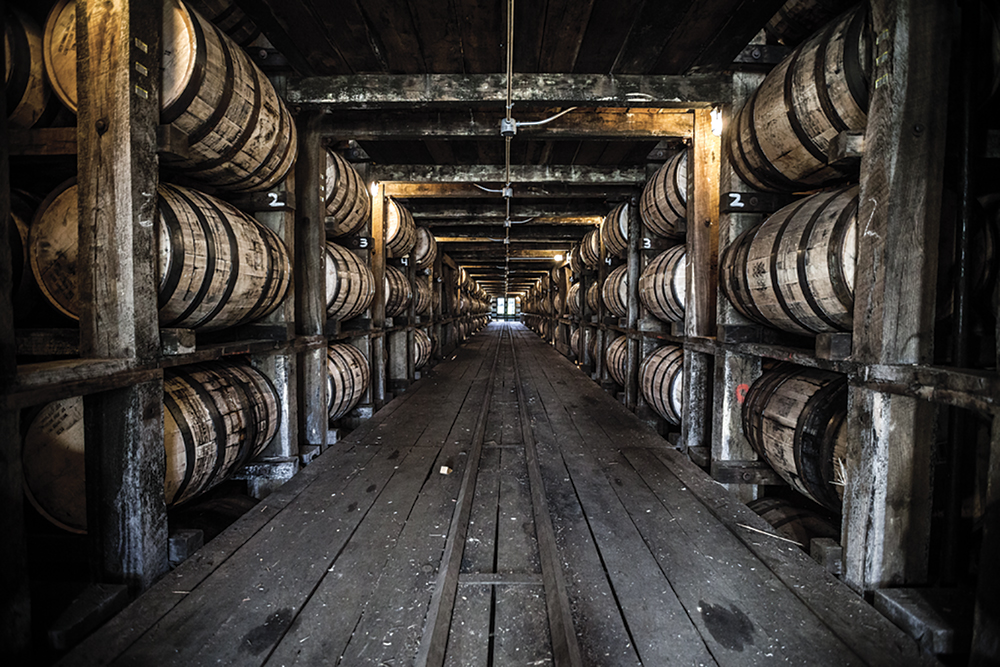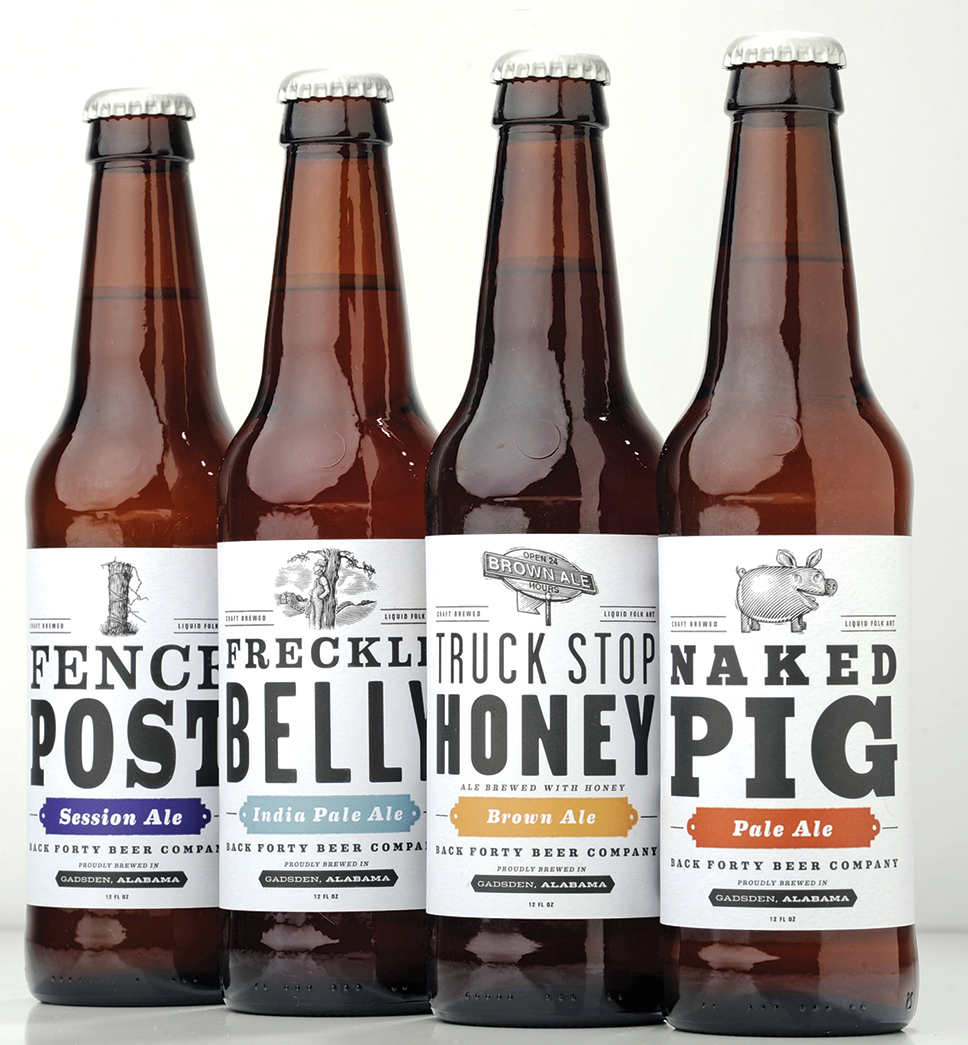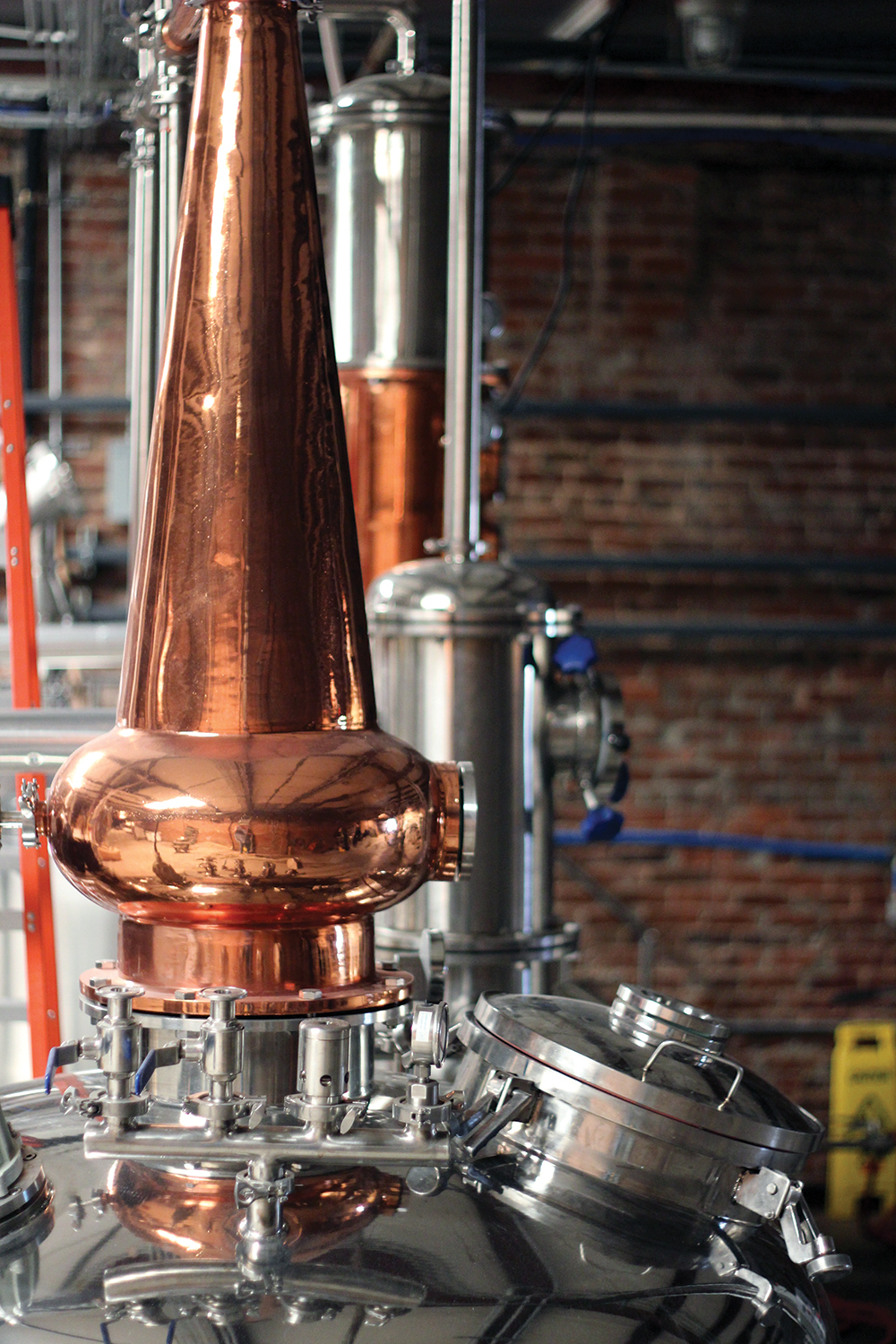
Distilleries, wineries, breweries make impact on state’s economy
By Jennifer Kornegay
Beer, wine and spirits production in Alabama is a growing business segment, one quickly becoming a significant piece of the state’s economic puzzle. Thanks to a loosening of liquor laws over the last seven years, we’re experiencing a craft-brewery boom. It started with only one in 2008. After a few years of fermentation, there are now more than 28 (with a few more set to open soon) scattered all over the state.
Those growing our native grapes and transforming their juice into flavorful wines are flourishing, too. Established vineyards are expanding and new ones are being founded.
In 2013, the state’s first legally made liquor since prohibition was distilled, and there are now several companies giving us Alabama-made spirits, letting us mix a little state pride into our cocktails.
We even scored a leading role in the storied imbibing institution of another state. The barrels that hold one of the world’s most loved (and well-known) whiskeys are made in Alabama.
Here’s a quick look at the business side of booze in our state.
Foaming facts
 In 2009, when changes to state law made opening a craft brewery possible, beer production in Alabama hopped up from 1,000 barrels annually to almost 30,000 barrels by 2013. That number is still steadily rising, as the breweries currently operating in the state are malting, milling, mashing and fermenting more and more and turning out a diverse array of suds that seems to be ever expanding. And there are several new breweries slated to open this year, pushing the total to 34.
In 2009, when changes to state law made opening a craft brewery possible, beer production in Alabama hopped up from 1,000 barrels annually to almost 30,000 barrels by 2013. That number is still steadily rising, as the breweries currently operating in the state are malting, milling, mashing and fermenting more and more and turning out a diverse array of suds that seems to be ever expanding. And there are several new breweries slated to open this year, pushing the total to 34.
According to Dan Roberts, executive director of the Alabama Brewers Guild, the growth has been “explosive.” Folks had been thirsty for Alabama-brewed beer for a long time before the top was popped on the industry, and the demand is still going strong and keeping the breweries busy. “Most are having a hard time keeping up,” he says. “That bodes well for the future.”
It bodes well for all Alabamians too. A 2015 study conducted by Jacksonville State University found that the state’s craft breweries are having a $100 million economic impact. That’s a lot of money, but Alabama-based breweries still hold only a tiny fraction of the market share for beer consumed in our state.
“We are about 1 percent, so there is a lot of room to grow,” Roberts says. “And we have a lot of growth left in us. We’re not at the apex yet; there’s still a ton of potential.”
Just like the initial law change in 2009 that got the industry going, as more restrictions are removed allowing product to move to its market faster and easier, the brewing business attracts more people and creates more jobs. One longed-for piece of legislation, known as the “beer to go” bill, finally became law in 2016.
Since June, breweries and brewpubs have been able to sell customers beer in containers they can take home. “Most of the legal hurdles are down now,” Roberts says. “It’s now on the breweries to make good beer and make smart decisions.”
But what the state’s booming beer industry is providing equals more than the sum of its economic impact numbers. According to Jason Wilson, founder of Gadsden’s Back Forty Beer Co. and president of the Brewers Guild, it’s also had positive social and cultural effects.
“It’s great because we’re now keeping some of the money spent on beer here in the state, but it’s beyond that. It’s a representation of an increased interest in new ideas and in things really ‘crafted,’” he says. “It’s also showing how consuming beer responsibly can be an enjoyable part of our lifestyle here.”
And most of our craft breweries are owned by folks from the cities and towns in which they are based, like Back Forty. “I’m a fifth generation living in Gadsden,” Wilson said. “And that’s how it is for a lot of us (in the brewing industry). We’re involved in our communities and committed to their futures, so we give back. As we are successful, we work to make the places we call home more successful too.”
Barreling along
It’s true of anything we eat or drink: Quality ingredients yield a better tasting product. When it comes to whiskey, the ingredient list includes wooden barrels.
 “At Jack Daniels, we consider the wood an ingredient; without the wood and the charring, you get no color; whiskey is actually distilled clear. It also helps with flavor. Up to 50 percent of a whiskey’s flavor comes from its barrel,” says Derrick Connor, the plant director at the Jack Daniels Cooperage in Trinity, the place making a good portion of these barrels.
“At Jack Daniels, we consider the wood an ingredient; without the wood and the charring, you get no color; whiskey is actually distilled clear. It also helps with flavor. Up to 50 percent of a whiskey’s flavor comes from its barrel,” says Derrick Connor, the plant director at the Jack Daniels Cooperage in Trinity, the place making a good portion of these barrels.
The cooperage started crafting the crucial storage vessels for several versions of Jack Daniels Whiskey, including the famous Old No. 7, in July 2014. Today, approximately 118 employees contribute their labor and skill at the 60-acre site to make 800 to 1,000 barrels a day. (Jack Daniels is one of the only distilleries in the world to still make its own barrels.)
Joe Wheeler Electric Membership Cooperative, one of Alabama’s 22 rural electric cooperatives, supplies electricity to keep the plant running.
As Connor explained, the barrels they’re building are integral to the product’s final form. Whiskey ages and mellows once put in a barrel, soaking up some of the wood’s rich, earthy flavor while the wood also removes impurities that can mar the liquid’s smooth finish.
It all starts with the trees. “All of our wood is white oak, trucked in from mills in Stevenson, Ala., or Clifton, Tenn.,” Connor says. These wood planks are then transformed into tastemakers by a combination of automated and hand assembly. The wood is dried in a kiln, making it easier to cut into staves (the pieces that make the sides of the barrel) and heads (the round pieces that cap the top and bottom).
The heads are planed by a machine, and then sent to a rounding table where workers finish them by hand. The staves are cut to size and angled joints are added, allowing the barrel to be put together in the next step.
When the elements are all cut and approved, it’s time to “raise” the barrel. This is when a worker forms the staves into the traditional barrel shape. A quick ride through a steam tunnel makes the staves pliable, so the barrel will be more accepting of the metal rings dropped around it, and then it heads toward the real heat.
The charring process is quick but intense. Each barrel is run over a natural gas flame and is allowed to ignite for 15 seconds; tongues of fire flicker along its inside walls and burn them black, creating a layer of charcoal, before the blaze is extinguished. “It’s really pretty exciting to watch,” Connor says. The whiskey seeps about ½ inch deep into the barrels’ sides, which are now coated in a natural charcoal filter that removes any impurities.
The cooperage is one of two that serve Jack Daniels (the other is in Kentucky) and is currently focused on more hiring and training as future growth is expected.
In high spirits
 In 2013, the first liquor produced legally in Alabama since prohibition started flowing from Union Springs, a spot infamous for secret moonshine stills, when High Ridge Spirits started making its legitimate “liquid lightning.” High Ridge Spirits is currently making three ‘shines, the original Stills Crossroads Alabama ‘Shine and two flavored versions, Apple Pie and Peach. It also offers its 27 Springs Gin and Vodka.
In 2013, the first liquor produced legally in Alabama since prohibition started flowing from Union Springs, a spot infamous for secret moonshine stills, when High Ridge Spirits started making its legitimate “liquid lightning.” High Ridge Spirits is currently making three ‘shines, the original Stills Crossroads Alabama ‘Shine and two flavored versions, Apple Pie and Peach. It also offers its 27 Springs Gin and Vodka.
In the three years since High Ridge Spirits started, several other small-batch craft distillers have begun bottling, including Redmont Distilling in Birmingham, Gibson Distilling in Dale County, Wolf Creek Distillery in Elberta and John Emerald Distillery (JED) in Opelika.
Founded by father-son team John and Jimmy Sharp in 2014, JED is named after Jimmy’s grandfather. After brewing beer at home for years as a hobby, the duo thought about doing it professionally. “We actually always enjoyed whiskey more, but we didn’t think we could do that legally in Alabama,” Jimmy says. When they found out they could, and noted the number craft breweries already popping up around Alabama, they decided to found their distillery, which makes John’s Alabama Single Malt Whiskey, Gene’s Spiced Rum (made with Alabama-farmed sugar cane) and Hugh Wesley’s Gin (made with juniper berries that grow wild in area woods).
Sharp is excited by the new laws that allow distilleries to conduct both on- and off-premise sales and believes it will lead to an expansion of the industry. “It means a smaller distillery can become a viable as business,” he says. “I think we can expect several more super micro distilleries to open up in the next few years.”
More distilleries mean more jobs and more taxes flowing into local and state coffers. “The new laws also encourage smaller experimental runs, which should lead to some interesting products in the future,” Sharp said.
Great grapes
When you think of wine, does Alabama come to mind? Maybe not. But maybe it should. The state currently has 17 wineries that cultivate plump grapes, crush and ferment them, and bottle the resulting liquid. Most rely on our area’s only native grape, the muscadine, although a few grow other varieties like Norton, and one, Maraella Winery in Hokes Bluff, is growing old world cabernet grapes. All total, more than 250 different wines are being made in Alabama.
Wineries have been operating here for years before a single brewery or distillery opened (the first, Perdido Vineyards, opened in 1972), and since 2011, the production of wine in Alabama has more than tripled, with the state’s production volume rising from No. 41 to No. 37 in the country.
This year, this segment of the alcohol industry is benefitting from new laws too. One of them gives Alabama’s wineries the ability to open a tasting room that’s separate from their vineyard and winery operations location. Wineries could already sell their product directly to customers, but only at the facility where it was made. A second new law allows wineries to offer samples and hold tasting events at other retail businesses (as long as they have a license for off-site-consumption liquor sales).
Thanks to the many changes in the legal environment in the last few years, the business of making and selling beer, wine and spirits is going strong and still growing in our state. It’s all part of larger “maker movement,” a return to the heritage of taking the time to make things locally and make them right that should make Alabamians proud. But there’s more to it than that; beyond the “home state” pride these companies and their products can induce, they’re providing needed jobs and having an increasingly positive economic impact on the cities and communities in which they’re based as well as on the entire state. Everybody can say cheers to that.
See & Sip
If you want to learn more about the making of Alabama wine, beer and spirits, check out a few of these spots that offer tastings, behind-the-scenes tours or both. Check their websites for specifics.
Beer
- Avondale Brewing Co., Birmingham, avondalebrewing.com
- Back Forty Beer Company, Gadsden, backfortybeer.com
- Fairhope Brewing Company, Fairhope, fairhopebrewing.com
- Straight to Ale, Huntsville, straighttoale.com
Spirits
- John Emerald Distilling, Opelika, johnemeralddistilling.com
Wine
- Whippoorwill Vineyards, Notasulga, whippoorwillvineyards.com
- Morgan Creek Winery, Harpersville, morgancreekwinery.com
- Wills Creek Winery, Duck Springs, willscreekwinery.com
- Ozan Vineyard & Winery, Calera, ozanwine.com
- Perdido Vineyards, Perdido, perdidovineyards.net
New beer trail highlights craft breweries in North Alabama
The Alabama Mountain Lakes Tourist Association (AMLA) has announced the new North Alabama Craft Beer Trail and the North Alabama Craft Beer Passport. The Trail invites craft beer enthusiasts on a self-guided tour of eight North Alabama microbreweries offering hundreds of unique flavors custom to the region.
Available on www.northalabama.org, the self-guided tour features eight microbreweries and tasting rooms located in Florence, Huntsville, Madison, Cullman, Guntersville and Gadsden. “Designed for residents and visitors to enjoy, the North Alabama Craft Beer Trail is a unique attraction highlighting Alabama-made beer while providing a boost to the North Alabama economy,” said AMLA President/CEO Tami Reist. “The Trail spotlights fresh, locally-brewed beer and is another opportunity to give visitors a unique destination experience that can only be enjoyed in North Alabama.”
Participating breweries on the North Alabama Craft Beer Trail:
Goat Island Brewing, Cullman
Singin’ River Brewing, Florence
Back Forty Beer Company, Gadsden
Main Channel Brewery, Guntersville
Mad Malts Brewing, Huntsville
Salty Nut Brewery
Straight to Ale, Huntsville
Blue Pants Brewery, Madison
Passage of the Free The Hops Gourmet Beer Bill in 2009, the Brewery Modernization Act in 2011, and the 2016 Growler Bill removed some of the restrictions on beer production and consumption in Alabama and has led to an increase in the creation of microbreweries in the state. The Alabama Brewers Guild estimates as many as 300 people work in Alabama-based breweries or brewpubs and an economic analysis produced for the trade group by Jacksonville State University estimated that total employment could increase by 655 jobs within five years under the new law, with an additional economic output of more than $100 million.
Along with information available online, a new tourism brochure has been developed providing craft beer lovers with location information, beer selections, taproom hours, tour information and a passport. Brochures can be obtained by calling AMLA at 800-648-5381 or are available at the AMLA office or at any participating brewery.
To participate in the North Alabama Craft Beer Trail, stop by any participating brewery to pick up a passport. Visit each one and receive a stamp. After completing the passport, craft beer enthusiasts will be able to win a free keepsake bottle opener as a prize from AMLA.
The North Alabama Craft Beer Passport is modeled after the North Alabama Wine Trail Passport created by AMLA. Visitors stop by the six locations of the North Alabama Wine Trail to receive a stamp. After visiting all locations, wine lovers return the completed passport to AMLA for a free gift.
According to Becky Berta of Jules J. Berta Winery, the North Alabama Wine Trail and Passport has had a direct impact on their bottom line. “The North Alabama Wine Trail’s marketing efforts of a brochure and passport have paved a way for attracting new business and now we are seeing many repeat customers. The Trail has brought the six wineries together and allows us to create special events and cross-promote one another. If you want to create a spark in your business, you have to actively promote it, and The Wine Trail and Passport have given us just that,” said Berta. The Trail and Passport launched in the spring of 2015 and approximately 1,000 visitors have completed the Trail.
Information related to the Trail and Passport can be found at http://www.northalabama.org/explore/craft-beer. The North Alabama Craft Beer Trail is membership-based.
For more information or to inquire about joining, call AMLA at 256-350-3500.




